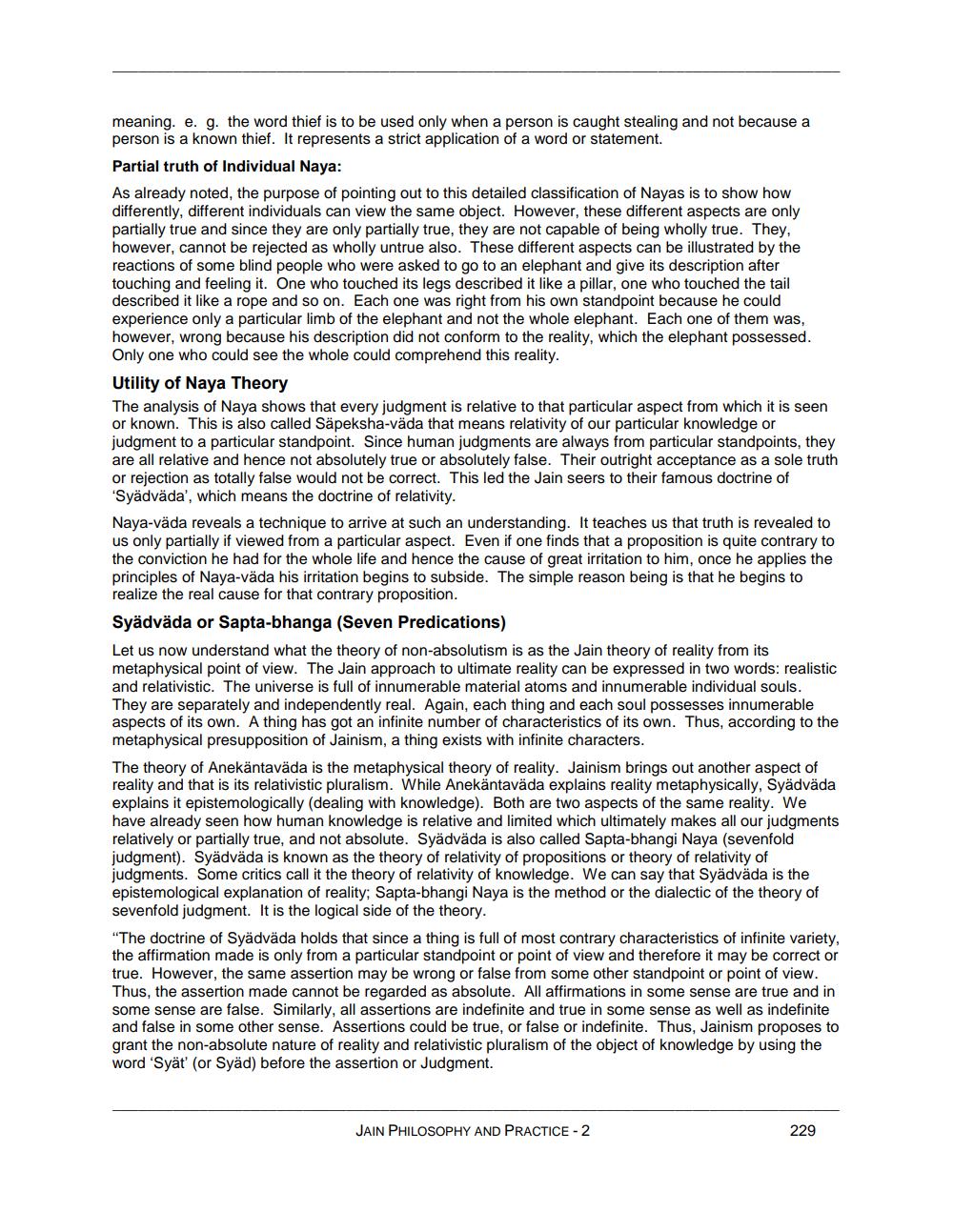________________
meaning. e. g. the word thief is to be used only when a person is caught stealing and not because a person is a known thief. It represents a strict application of a word or statement.
Partial truth of Individual Naya:
As already noted, the purpose of pointing out to this detailed classification of Nayas is to show how differently, different individuals can view the same object. However, these different aspects are only partially true and since they are only partially true, they are not capable of being wholly true. They, however, cannot be rejected as wholly untrue also. These different aspects can be illustrated by the reactions of some blind people who were asked to go to an elephant and give its description after touching and feeling it. One who touched its legs described it like a pillar, one who touched the tail described it like a rope and so on. Each one was right from his own standpoint because he could experience only a particular limb of the elephant and not the whole elephant. Each one of them was, however, wrong because his description did not conform to the reality, which the elephant possessed. Only one who could see the whole could comprehend this reality.
Utility of Naya Theory
The analysis of Naya shows that every judgment is relative to that particular aspect from which it is seen or known. This is also called Säpeksha-väda that means relativity of our particular knowledge or judgment to a particular standpoint. Since human judgments are always from particular standpoints, they are all relative and hence not absolutely true or absolutely false. Their outright acceptance as a sole truth or rejection as totally false would not be correct. This led the Jain seers to their famous doctrine of 'Syädväda', which means the doctrine of relativity.
Naya-väda reveals a technique to arrive at such an understanding. It teaches us that truth is revealed to us only partially if viewed from a particular aspect. Even if one finds that a proposition is quite contrary to the conviction he had for the whole life and hence the cause of great irritation to him, once he applies the principles of Naya-väda his irritation begins to subside. The simple reason being is that he begins to realize the real cause for that contrary proposition.
Syädväda or Sapta-bhanga (Seven Predications)
Let us now understand what the theory of non-absolutism is as the Jain theory of reality from its metaphysical point of view. The Jain approach to ultimate reality can be expressed in two words: realistic and relativistic. The universe is full of innumerable material atoms and innumerable individual souls. They are separately and independently real. Again, each thing and each soul possesses innumerable aspects of its own. A thing has got an infinite number of characteristics of its own. Thus, according to the metaphysical presupposition of Jainism, a thing exists with infinite characters.
The theory of Anekäntaväda is the metaphysical theory of reality. Jainism brings out another aspect of reality and that is its relativistic pluralism. While Anekäntaväda explains reality metaphysically, Syädväda explains it epistemologically (dealing with knowledge). Both are two aspects of the same reality. We have already seen how human knowledge is relative and limited which ultimately makes all our judgments relatively or partially true, and not absolute. Syädväda is also called Sapta-bhangi Naya (sevenfold judgment). Syädväda is known as the theory of relativity of propositions or theory of relativity of judgments. Some critics call it the theory of relativity of knowledge. We can say that Syädväda is the epistemological explanation of reality; Sapta-bhangi Naya is the method or the dialectic of the theory of sevenfold judgment. It is the logical side of the theory.
"The doctrine of Syädväda holds that since a thing is full of most contrary characteristics of infinite variety, the affirmation made is only from a particular standpoint or point of view and therefore it may be correct or true. However, the same assertion may be wrong or false from some other standpoint or point of view. Thus, the assertion made cannot be regarded as absolute. All affirmations in some sense are true and in some sense are false. Similarly, all assertions are indefinite and true in some sense as well as indefinite and false in some other sense. Assertions could be true, or false or indefinite. Thus, Jainism proposes to grant the non-absolute nature of reality and relativistic pluralism of the object of knowledge by using the word 'Syät' (or Syäd) before the assertion or Judgment.
JAIN PHILOSOPHY AND PRACTICE - 2
229




